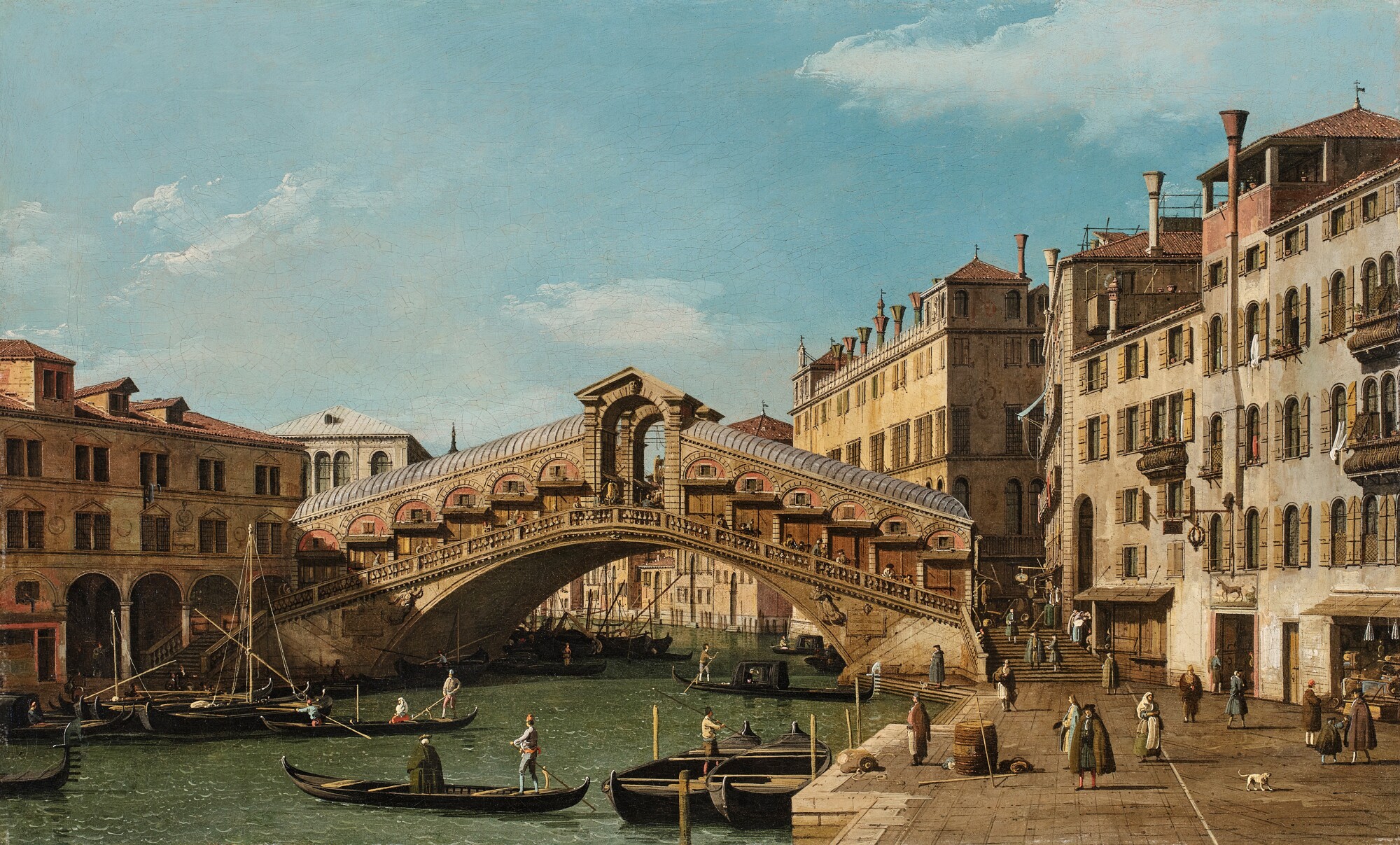By Charles Beddington
U ntil 1854 the Rialto Bridge was the only pedestrian route across the Grand Canal, joining the two halves of the city of Venice. All other crossing had to be by traghetti, or gondola ferries. A wooden bridge constructed in 1264 is shown in Vittore Carpaccio’s The True Cross Healing a Possessed Man of circa 1496, in Venice's Gallerie dell’Accademia.1 The wooden bridge was twice destroyed, in 1310, by Bajamonte Tiepolo during his uprising and in 1444, under the weight of the crowd straining to see the Marquis of Ferrara. In 1554 a competition for the honor of designing a stone bridge was held and attracted the participation of such illustrious architects as Andrea Palladio, Jacopo Sansovino, Giacomo Vignola, and Vincenzo Scamozzi. It was won, however, by the less well-known but appropriately named Antonio da Ponte (1523-1595), who designed and built the present structure between 1588 and 1591 with help from his nephew Antonio Contin (circa 1566-1600). A remarkable feat of engineering, it fulfills its purpose perfectly, not least in including two rows of shops, and is justly famous worldwide. It is adorned with a memorial inscription to Doge Pasquale Cicogna (in office 1585-1595) and relief sculptures showing the Annunciation (the Republic’s mythical "birthday," 25 March 421, was on the Feast of the Annunciation).

The Rialto Bridge is the only one of the Venice's most prominent landmarks that is set apart from the area of the Piazza San Marco and the Bacino di San Marco. As such it was largely overlooked by Luca Carlevarijs, Canaletto’s foremost precursor. Although views of it from two different angles are included among the former's etchings published in 1703,2 and he painted it three times, none of those shows the bridge from the south, the viewpoint employed here.3 It was left to Canaletto to develop the possibilities of the subject and its potential appeal to clients. He painted it from both sides and also at a distance from the south. His earliest depictions of it from that vantage date from as early as circa 1724-1725, a very large canvas last recorded in a Paris private collection,4 and a small version thereof.5 To the later 1720s are datable a variant on copper in the collection of the Earl of Leicester at Holkham Hall,6 and a much-copied version sold at Sotheby’s, New York, in October 2020.7 A version of circa 1734 forms part of the celebrated large series of Venetian views in the collection of the Duke of Bedford at Woburn Abbey.8
This painting, which is of very similar scale to the Woburn canvas, was introduced to the Canaletto literature by J.G. Links, who emphasized its differences from previous variants and the accuracy of its topographical detail. Although Links does not discuss dating, it is clearly of circa 1740 and is thus, by several years, the latest of the artist’s paintings of the composition. It is also the only version dating from the brief period when Canaletto’s style is at its coldest and most precise. That moment produced more than its fair share of masterpieces, above all the frosty panoramic view of the Bacino di San Marco, Looking East, in Boston's Museum of Fine Arts,9 and the Grand Canal at San Simeone Piccolo, in London's National Gallery,10 which are unequalled in their translucence and precision.
A finished drawing of the early 1740s in the Royal Collection largely repeats the composition, although it omits the buildings on the right and differs in the boats and figures.11
1 Inv. no. 566.
2 I. Reale, Luca Carlevarijs: Le Fabriche, e Vedute di Venetia, exhibition catalogue, Udine 1995, pp. 105-106, cat. nos. 56, 57.
3 D. Succi, Luca Carlevarijs, Gorizia 2015, pp. 160-162, cat. no. 21; pp. 215-216, cat. no. 77; p. 217, cat. no. 80.
4 W.G. Constable, Canaletto, Giovanni Antonio Canal, 1697-1768, Oxford 1989, vol. II, p. 295, cat. no. 227*, reproduced pl. 199; Canaletto prima maniera, exhibition catalogue, Venice 2001, pp. 158-159, cat. no. 59, reproduced; C. Beddington, “Some little-known Venetian views by Canaletto of the 1720s,” in Burlington Magazine 148, no.1244 (November 2006), p. 776, reproduced fig. 50.
5 Constable 1989, vol. II, p. 295, cat. no. 227*(a); Beddington 2006, pp. 776-777, reproduced fig. 51.
6 Constable 1989, vol. II, p. 294, cat. no. 226, reproduced pl. 47; Canaletto e Venezia, exhibition catalogue, Venice 2019, p. 127, cat. no. IV.02.
7 Constable 1989, vol. II, p. 295, cat. no. 227(d), reproduced pl. 199; sold from the collection of Ambassador and Mrs. Felix Rohatyn, Sotheby’s, New York, 14 October 2020, lot 12.
8 C. Beddington, Canaletto: Painting Venice, The Woburn Series, Bath and London 2021, pp. 98-103, cat. no. 11.
9 Inv. no. 39.290. Constable 1989, vol. II, p. 250, cat. no. 131, reproduced pl. 32.
10 Inv. no. NG163. Constable 1989, vol. II, p. 318, cat. no. 259, reproduced pl. 52.
11 Constable 1983, vol. II, p. 509, cat. no. 591, reproduced pl. 108.

